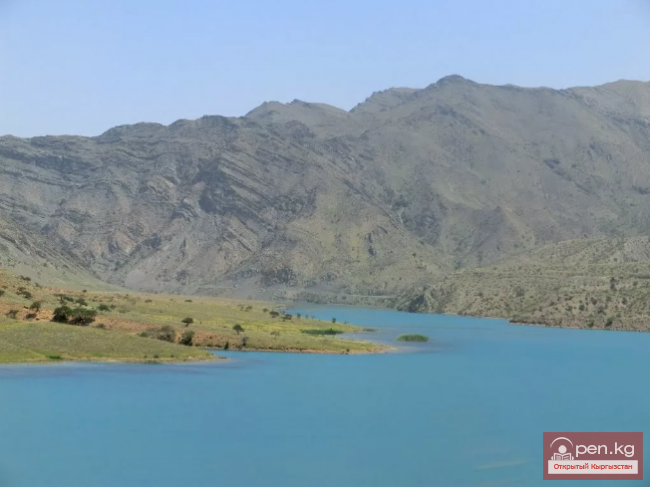
The morning is clear and transparent, filled with freshness, sharply revealing the curves of...

About Deserts 1. Deserts cover about one-fifth of the Earth's land surface, with half of this...

Rocky Canyons of the Kok-Kiya Valley Kyrgyzstan is rich in beautiful and unique places. In the...

Sharkyratma Waterfall It is located about a 40-minute walk from the alpine camp on the way to the...
The Kegety Gorge is located 75 km from Bishkek on the northern slopes of the Kyrgyz Ridge and is...

Before your eyes stretches the unrestrained blue of the water, which sharply contrasts with the...

The weather was magnificent. The road, like a red arrow, cut through the jungle. It sped towards...

The Chichkan River flows from the north into the Toktogul Reservoir. It is a small river with...

Water - The Basis of Life The peoples of Central Asia and Kazakhstan, who roamed the endless...

Narrow echoing gorges, through which in the gloomy depths flows a river bound by rocky jaws;...

Kyzyl-Suu (Kyzyl-Suu River, Красная река) - a river in Kyrgyzstan and Tajikistan, the right source...

Geographical Information: The lake is located in the Naryn region, Ak-Sai valley, on the border...

Muzdag Mountains, Khan Tengri Peak, and Victory Peak. The Muzdag mountain range (ice mountains) is...

It is very hot and stuffy on the plane, and outside the window, it is deep night. We are flying...

Isfayramsay A river in Kyrgyzstan and Uzbekistan, a left tributary of the Syr Darya. Its total...

Aflatun River – the largest right tributary of the Kara-Suu River in the Jalal-Abad region. The...

Karakulja The Chatkal River in its upper reaches is called Karakulja (translated - Black Ram),...

We arrived in Puerto Princesa by plane from Manila. The runway, flat as a table and paved with...

"Hudud al-Aalam" about the "Priirtysh" Kyrgyz...

Zone "Isfayram-Sai". The left tributary of the Isfayram-Sai River is the Surme-Tash...

Kasansay (Kyrgyz: Kasan-say, Uzbek: Kosonsoy) A river in Kyrgyzstan and Uzbekistan, a right...

The Red Water Gorge - Chon-Kyzyl-Suu The picturesque Chon-Kyzyl-Suu gorge is one of the most...

Small Naryn encompasses the valley of the river of the same name, located between the ridges of...

Issyk-Ata Zone is located 80 km from Bishkek and includes two gorges — Issyk-Ata and Tuyuk...

Botswana. Republic of Botswana A country in southern Africa. Area - 600.4 thousand km², 80% -...

Approximately a 2-hour journey from the Susamyr River is the Kekemeren River. The Kekemeren River...

Grigorievskoe Gorge is one of the wonderful and picturesque natural attractions Chon Ak-Suu Gorge,...

The Orto-Tokoy Zone encompasses the territorial foothills at the western end of the Terskey...

The Donkey Once, a donkey fell into a well. The owner thought about what to do. Finally, he made a...

Geographical Reference: In the eastern part of Kyrgyzstan, where the northern and southern arcs of...

The length of the valley is 155 km. It is bordered on the north by the Kyrgyz Ala-Too, on the...

Rashid ad-Din on the "Kyrgyz Tribe" According to Rashid ad-Din's information about...

As the party was set in motion, called dawn, the sun, breaking away from the surface of the ocean,...
API error: no response...

Boom Canyon is located 112 km from the city of Bishkek and serves as a unique natural gateway...

The "Padsha-Ata" zone includes the gorge of the same name and is located near the...

Kok-Kiya River (Green Slope) - the easternmost right tributary of Ak-Sai, flows down from the...

Kursheb, Kursheb River, in the upper reaches — Gulcha, A river in Kyrgyzstan, flowing through the...

Alamedin Zone is located 25 km from Bishkek in the valley of the same name and the surrounding...

Kegety Zone is located 75 km from Bishkek in the gorge of the same name on the road to the village...

“Gates of Hell,” Karakum Desert Darvaza, or as it is also called, the Gates of Hell, is the most...

Unique Planet Earth Planet Earth is just one of eight (according to the latest data) planets in...

Kyrgyzstan: A Country of Heavenly Lakes Kyrgyzstan can confidently be called a country of heavenly...

The airport in Manila is as crowded as an anthill. There are a huge number of flights. The...

The Most Unexplored Places on Our Planet Climate and human factors constantly affect the Earth. It...

The main channel of the Ak-Suu River is at least 20-22 kilometers long. The lower part of the...

Ancient Kyrgyz Ideas about the Structure of the World Human thought has never been satisfied with...

The bus to Puno departed at eight in the morning. The morning bad weather, curling like a gray...